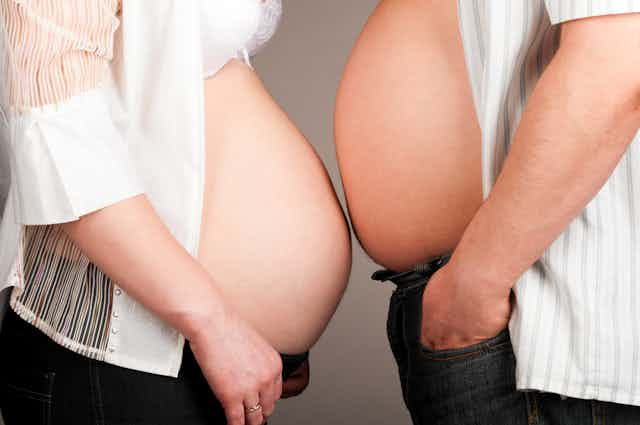Children born to obese women have double the chance of being obese themselves by age two, compared to children born to women of a recommended body mass index (BMI). Childhood obesity is also strongly linked with obesity in fathers.
But how can obesity in adults influence the weight of their children? The answer lies in eggs and sperm. Research shows that egg and sperm cells contain not only the DNA blueprint for a child’s genetics, but they also carry molecules that respond to the nutritional intake of parents. These molecules can shape characteristics of the child, including determining risk of obesity.
It’s why the Council of Presidents of Medical Colleges identified pre-conception planning among its six-point plan for action on obesity published this week.
Both mums and dads shape obesity
Obesity in young children is most closely associated with the mothers’ BMI at the time she conceives, as opposed to her weight gain during pregnancy. Childhood obesity is also associated with obesity in fathers. Paternal BMI is linked with birthweight of baby boys, and fatness of fathers correlates with daughters’ increase in body fat from age five to nine.
Compared to when only one parent is overweight, the risk of children becoming overweight doubles again with two obese parents. This suggests there are distinct biological mechanisms from each of mum and dad that amplify the child’s susceptibility to obesity. Alterations to both egg and sperm are thought to transmit signals to the embryo and shape risk of future obesity.
Eggs and sperm are more than just DNA
You may recall being taught that sperm carried nothing more than DNA to the egg at conception. However, it has recently been discovered that sperm also carry signals in the form of molecules called non-coding RNAs. Once inside the egg after fertilisation, these molecules can influence how development proceeds.
Our research has shown non-coding RNAs are different in the sperm of male mice that are obese compared to mice that are not. Other studies have shown if just the non-coding RNA from sperm of obese mice is injected into mouse eggs, it makes offspring fatter. Non-coding RNAs are also changed in the sperm of obese men, and these may be acting to make children from obese fathers fatter.
Eggs contain all of the building blocks needed to make an embryo, and these are influenced by the mother’s nutrition. For instance, females who eat more fat have more fat in their eggs. This is likely to influence the embryo’s metabolism – that is, its ability to burn energy efficiently – after fertilisation. Indeed, IVF-generated embryos from obese women have been shown to have different metabolism compared to those from non-obese women.
What is emerging as particularly important in this picture is the mitochondria – often called the “powerhouse” of the cell – which metabolise the fats and sugars in cells to make energy. Egg mitochondria are defective in obese females, and this has consequences for obesity susceptibility in the offspring that come from these eggs.

All of your mitochondria in all of the cells of your body are thought to be derived from the mitochondria within the egg; they are maternally inherited. If there is a deficiency in the egg’s mitochondria, this is perpetuated into the tissues of the offspring.
For example, the same defects in the egg’s mitochondria from obese female mice are found in the muscle of her pups. This alters the metabolism of the whole animal, increasing lifelong susceptibility to obesity and diabetes. This is one pathway through which the egg’s exposure to obesity goes on to shape likelihood of obesity in offspring.
Don’t panic, just get a little healthier
Embryos are often described as being “plastic”: they respond to external signals and adapt their growth and development accordingly. Thus not only do eggs, sperm and embryos react to negative signals such as fatty diets, they will also respond to good nutrition and therapies. So it is entirely possible that changing lifestyle habits can create positive effects in eggs, sperm and embryos.
Treating obese female mice with anti-diabetes drugs for just four days improves the quality of their eggs. This would equate to approximately one month of treatment in women. Exercise also improves egg quality in mice.
Improvements in sperm quality have been reported in obese mice who were exercised, and sperm non-coding RNA content can be restored by exercise. The transmission of obesity to offspring is stopped by diet and exercise interventions in obese male mice, possibly in part via restoration of sperm non-coding RNA.
Similar effects of good nutrition and exercise on egg and sperm characteristics are expected to be seen in humans, but there is little data to date. Two studies have shown that children conceived after the mother had gastric banding were less obese than siblings conceived by the same mother prior to gastric banding. But losing weight via diet and exercise prior to pregnancy would be just as effective.
Further, we need more clear advice for women who are already pregnant because this is typically when they become most dedicated to being healthy. As such, a number of large international research teams are focused on optimising interventions for obese mothers, including immediately prior to pregnancy. Also as the pre-clinical research highlights, these interventions should be expanded to fathers before conception too.
There is clear biological evidence supporting the policy message that preventing obesity in our adolescents and young adults – while they are in school, at home and before they have children – can shape obesity rates in the whole community.

